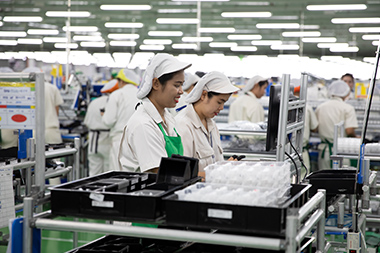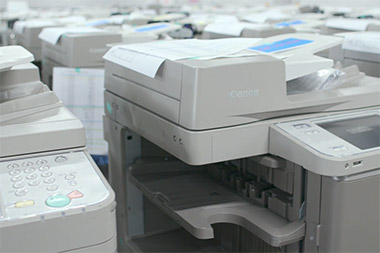Production is at the core of monozukuri. The production process encompasses procurement of input materials for parts and components, manufacturing and processing, assembly of components into the finished product, and finally, testing and inspection.
Making technically advanced products requires advanced equipment as well as highly skilled operators. Production equipment can take many different forms: the complex machinery and equipment combinations used to make input materials for production; molding machines that fabricate parts by pouring molten metal or resin into molds; automated processing and assembly lines; and testing equipment that can identify defects and nonconformities. In addition, high-quality production requires skilled workers with the expertise needed to make components and assemble products to a high degree of precision and the knowledge to use the production equipment in the correct manner.
Canon employs a “cell system” of production, in which individual teams are given responsibility for assembly of finished products. Cell production has contributed significantly to the evolution of monozukuri, giving rise to the man-machine cell production system that incorporates robot production processes with human workers, as well as the Canon Meister designation that recognizes people who have mastered hundreds of pages of procedural manuals. Similarly, the Chie-tech, or “smart design equipment” program encourages production workers to put forward suggestions for making low-cost tools and processes, and has substantially improved production efficiency. Also, skilled veterans designated as Master Craftsmen provide mentoring and additional training to younger workers in areas that require special expertise, such as lens polishing and metal mold fabrication.
An important feature of the Canon monozukuri approach is the shift toward in-house production of key parts and components.
Canon is committed to developing its own material processing methodologies and production equipment as well as boosting the proportion of components and equipment produced in-house. At the same time, Canon is also working toward 24-hour operation through the use of fully automated production lines. Automation is steadily being introduced to processing, packaging, on-site transportation and testing and inspection processes, and automated assembly machines are also in the works. In this way, Canon is leading the global push toward automated factories, with the aim of ensuring a reliable and consistent supply of high-quality products.














